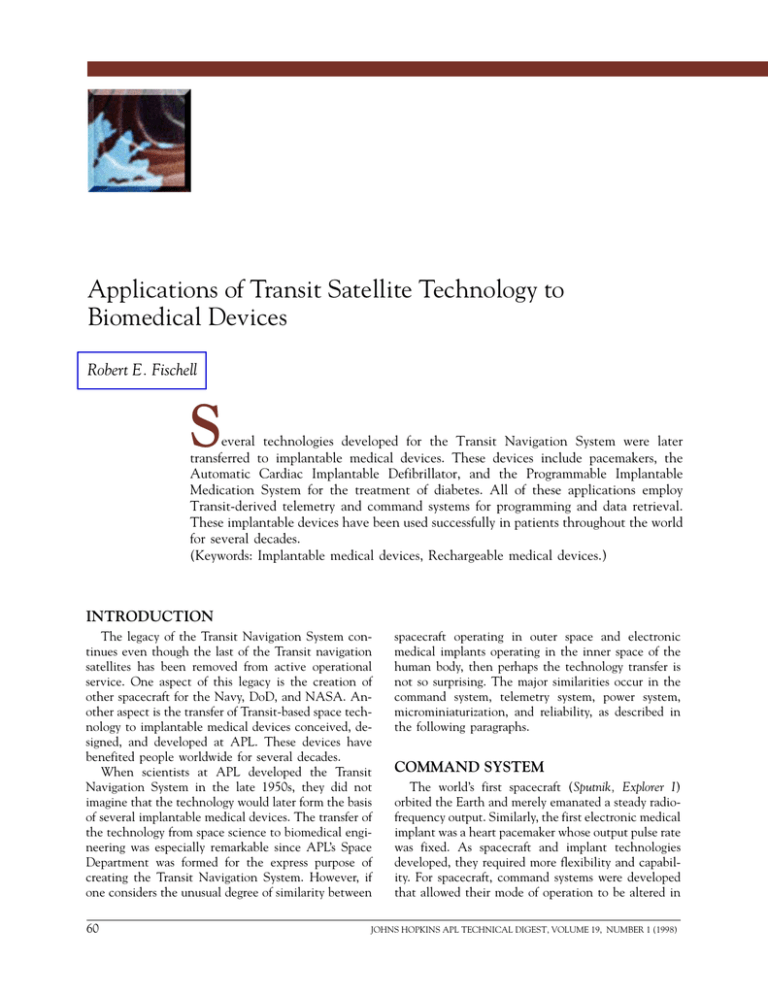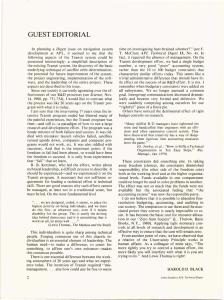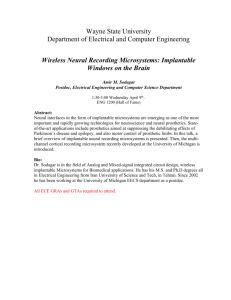S Applications of Transit Satellite Technology to Biomedical Devices Robert E. Fischell
advertisement

R. E. FISCHELL Applications of Transit Satellite Technology to Biomedical Devices Robert E. Fischell S everal technologies developed for the Transit Navigation System were later transferred to implantable medical devices. These devices include pacemakers, the Automatic Cardiac Implantable Defibrillator, and the Programmable Implantable Medication System for the treatment of diabetes. All of these applications employ Transit-derived telemetry and command systems for programming and data retrieval. These implantable devices have been used successfully in patients throughout the world for several decades. (Keywords: Implantable medical devices, Rechargeable medical devices.) INTRODUCTION The legacy of the Transit Navigation System continues even though the last of the Transit navigation satellites has been removed from active operational service. One aspect of this legacy is the creation of other spacecraft for the Navy, DoD, and NASA. Another aspect is the transfer of Transit-based space technology to implantable medical devices conceived, designed, and developed at APL. These devices have benefited people worldwide for several decades. When scientists at APL developed the Transit Navigation System in the late 1950s, they did not imagine that the technology would later form the basis of several implantable medical devices. The transfer of the technology from space science to biomedical engineering was especially remarkable since APL’s Space Department was formed for the express purpose of creating the Transit Navigation System. However, if one considers the unusual degree of similarity between 60 spacecraft operating in outer space and electronic medical implants operating in the inner space of the human body, then perhaps the technology transfer is not so surprising. The major similarities occur in the command system, telemetry system, power system, microminiaturization, and reliability, as described in the following paragraphs. COMMAND SYSTEM The world’s first spacecraft (Sputnik, Explorer I) orbited the Earth and merely emanated a steady radiofrequency output. Similarly, the first electronic medical implant was a heart pacemaker whose output pulse rate was fixed. As spacecraft and implant technologies developed, they required more flexibility and capability. For spacecraft, command systems were developed that allowed their mode of operation to be altered in JOHNS HOPKINS APL TECHNICAL DIGEST, VOLUME 19, NUMBER 1 (1998) APPLICATIONS OF TRANSIT SATELLITE TECHNOLOGY orbit by a radio signal from a ground station. Examples of command functions used on the Transit spacecraft were those to turn various subsystems on or off, change the level of the radio-frequency output of a transmitter, replace a failed subsystem, and change a parameter of an orbiting experiment. For implanted electronic devices, command systems operate from a radio signal originating in a doctor’s console that is, of course, exterior to the patient. Examples of control commands in modern pacemakers are those to change the stimulation pulse rate, pulse voltage, or pulse width; enable or disable an electrical signal from the atrium; and adjust the sensitivity to an electrical signal from the ventricle. Just as a spacecraft’s command system permits the spacecraft to adapt to its environment, an implant’s command system allows the implant to be adapted to the patient’s changing needs. TELEMETRY SYSTEM Telemetry involves the transmission of data from a remote location. For spacecraft, telemetry is accomplished via modulated radio waves sent down to ground receiving stations. Typical measurements from a Transit satellite might be the confirmation of commanded parameters and the battery voltage, both in real time and as stored data. Similarly, typical implant telemetered data might be the confirmation of commanded parameters, the battery voltage, a stored measurement of the patient’s cardiac arrest, and the rate of infusing medication, both in real time and as stored data. POWER SYSTEM Power systems for spacecraft and implants must be small and long-lived. Both spacecraft and implant systems have used rechargeable nickel–cadmium cells to store energy and operate the system between recharges. More recently, the power demands of implantable medical devices have become so small that a single, AA-size, lithium primary cell can operate some devices without recharging for more than 10 years. MICROMINIATURIZATION For the Transit satellites, it was always a struggle for the spacecraft designers to meet payload size and weight limitations. Thus, an extraordinary effort was made to reduce size and weight while increasing operating capabilities; therefore, microminiaturization of electronics was commonplace in designing the Transit satellites. Reduced size and increased capabilities are also design challenges for implantable medical devices. The first pacemaker (circa 1960) used only two transistors, measured 7.5 cm in diameter and 2.5 cm thick, and weighed approximately 250 g. Modern multiprogram- mable pacemakers contain the equivalent of 100,000 transistors, yet have one-tenth the volume and onefifth the weight of the first pacemaker. Thus, while demonstrating considerably better performance, pacemaker electronics have been miniaturized so much that they are now being comfortably implanted in newborn babies. RELIABILITY An often overlooked and sometimes unglamorous aspect of both spacecraft and implants is reliability. The failure of a single Transit satellite would result in the loss of an extraordinarily expensive machine; therefore, a whole discipline of reliability was created to ensure a long life in orbit. Early spacecraft frequently failed during launch or after a few days in orbit, but the careful application of reliability engineering has resulted in extended life. The orbital lifetimes of APL’s Transit satellites, however, were several decades longer than anyone predicted. The situation for implantable medical devices was similar. The first pacemaker failed within 12 h of human implantation. In the early 1970s, many pacemakers failed in less than 2 years because of component failures. In the later 1970s, however, spacetechnology-derived reliability and quality assurance techniques were applied to the design of the APL rechargeable pacemaker. As a result, hundreds of these devices are still functioning today after 20 years of continuous operation in humans. THE APL RECHARGEABLE PACEMAKER As a result of U.S. Navy support for the development of reliable power system components for the Transit satellites, a class of highly reliable, hermetically sealed, rechargeable nickel–cadmium cells was developed. Figure 1 shows the results of 2 years of preflight testing and nearly 10 years of in-orbit experience for a battery of eight series-connected nickel–cadmium cells that provided energy for Transit navigational satellite No. 14. As seen in the figure, at the end of 9.5 years in orbit, there were 34,000 charge–discharge cycles of these cells. If a patient was required to recharge his implanted stimulator even as frequently as every day, these satellite results indicate that the cell would still be functioning after 93 years of continuous use. It was this type of reliability that encouraged scientists and engineers at APL to proceed in late 1967 with the development of a rechargeable cardiac pacemaker. The resulting device, manufactured by Pacesetter Systems (Sylmar, California) is shown in Fig. 2. After 6 years of intensive laboratory and animal testing, the APL rechargeable pacemaker was implanted in a human on 10 February 1973. By 1985, JOHNS HOPKINS APL TECHNICAL DIGEST, VOLUME 19, NUMBER 1 (1998) 61 R. E. FISCHELL Number of charge–discharge cycles 10 0 100 200 10,000 15,000 20,000 25,000 30,000 35,000 70 years equivalent of weekly cycling (3640 cycles) 8 Battery voltage (V) 5,000 6 Test phase In orbit 4 2 0 –2 –1 0 1 2 3 4 5 Elapsed time (years) 6 7 8 9 10 Figure 1. Battery voltage during discharge for Transit navigational satellite No. 14. In March 1977, at the end of 9.5 years in orbit, there were 34,000 charge–discharge cycles of the nickel–cadmium cells. Launch date: 25 September 1967; battery temperature range: 70–90°F; typical depth of discharge: 10%; discharge cycles per year: 3640. approximately 6000 rechargeable pacemakers were implanted in humans. At about that same time, an advanced lithium battery was produced for implantable pacemakers that made the rechargeable pacemaker obsolete. Even so, in 1993, 20 years after the first rechargeable pacemaker was implanted, 600 of those devices were still operating in people. Their average lifetime was about 15 years, 10 times longer than the other types of pacemakers that existed when the first rechargeable unit was implanted. THE AUTOMATIC IMPLANTABLE CARDIAC DEFIBRILLATOR In 1978, M. Mirowski, a physician from the Johns Hopkins School of Medicine, asked several researchers in the APL Space Department to assist in the development of a device to be implanted in the body that would automatically restart a heart that had stopped beating properly. That was the beginning of the Automatic Implantable Cardiac Defibrillator (AICD) program at APL. For several years, APL assisted in AICD development with NASA support. The same engineers who worked on Transit worked on improving the reliability of the AICD device. They also developed a system to record the patient’s electrocardiogram (ECG) both before and after ventricular fibrillation as well as alert the patient that an electrical pulse was about to be released. A block diagram of this system is shown in Fig. 3. The first recording of a patient’s ECG both before and after fibrillation occurred at Johns Hopkins Hospital using the system shown in Fig. 4. The system consists of the physician’s tabletop console, which outputs a patient’s heart action after fibrillation/ defibrillation. At the left front is a monitor–recorder (about the size of a hand-held calculator) worn on the 62 belt of the patient, which records the electrical action of the heart before, during, and after activation of the defibrillator. Electrodes in an elastic belt (right front) worn externally over the heart of the patient pick up and relay heart signals to the monitor–recorder. The implantable defibrillator was developed by Sinai Hospital (Baltimore, Maryland) and Intec Systems (Pittsburgh, Pennsylvania). The display and monitor–recorder were developed by APL under sponsorship of NASA’s Technology Utilization Office. Today, hundreds of thousands of AICDs are implanted in patients all over the world. THE PROGRAMMABLE IMPLANTABLE MEDICATION SYSTEM With support from NASA, the Programmable Implantable Medication System (PIMS) was conceived, designed, and developed at APL by various members of the Space Department, most of whom had worked on the Transit program. A photograph of the PIMS development team and F. J. Piotrow, the first human recipient of the device, is shown at the end of this article. The main use of this device is for insulin delivery in diabetic patients. Figure 5 is a block diagram that shows the various parts of the system. The implantable portion of PIMS, which contains the microcomputer subsystem, is called the Implantable Programmable Infusion Pump (IPIP). The physician uses a computer terminal to specify the dosage to be released by the IPIP. When medication Figure 2. Rechargeable pacemaker and charger head. JOHNS HOPKINS APL TECHNICAL DIGEST, VOLUME 19, NUMBER 1 (1998) APPLICATIONS OF TRANSIT SATELLITE TECHNOLOGY Test sequencer 1.25 V DC DC-to-DC converter Capacitors Dummy load Fibrillation detection circuitry Defibrillation electrode Sense defibrillation input Defibrillation precursor output Defibrillation precursor Low-voltage detector Magnetic reed switch Off “See doctor” warning Pulse generator “See doctor” warning Test Test sequencer “Tickle” electrode Read out Physiologic recording system On/off Asystole Housekeeping telemetry system Asystole detector Inputs To pacemaker telemetry transmitter Figure 3. Block diagram of the rechargeable Automatic Implantable Cardiac Defibrillator (AICD). is required, the patient uses a hand-held “patient’s programming unit” to activate the IPIP. Upon activation, medication is released within the constraints specified by the physician. The device for refilling the IPIP is called the “medication injection unit.” The last major portion of the PIMS is a telephone communication system, whereby patients at remote locations can have their IPIPs reprogrammed with a new prescription or can have stored telemetry data in the IPIP read out and displayed by the “medication programming unit.” Patient’s programming unit Physician’s console Medication Programming System Paper printer Medication programming unit Implantable Programmable Infusion Pump Electrodes on elastic belt Communication head Communication head Medication injection unit Telephone transceiver Audio input Telephone Portable monitor–recorder Figure 4. First recording system used with the Automatic Implantable Cardiac Defibrillator (AICD). Audio output Patient’s equipment Telephone transceiver Audio input Audio output Telephone Physician’s equipment Figure 5. Block diagram of the Programmable Implantable Medication System (PIMS). JOHNS HOPKINS APL TECHNICAL DIGEST, VOLUME 19, NUMBER 1 (1998) 63 R. E. FISCHELL The IPIP is disk-shaped and has a diameter of 8.1 cm, a thickness at its center of 1.8 cm, a thickness at its edge of 1.3 cm, and a weight of 171 g. The IPIP can be programmed for a constant or variable basal infusion of medication with a repetitive period ranging from 1 hour to 60 days. By far the most frequently used basal period is 24 hours. A period of 28 days is available, particularly for the infusion of sex hormones to mimic the female cycle. The medication programming unit can be used to program six different supplemental infusion profiles that the IPIP can deliver when such delivery is initiated by the patient’s programming unit. The latter unit can also turn off the IPIP for 1 hour at the patient’s request, countermand a prior command of the unit, or change the basal infusion rate to either half or full basal. Figure 6 is a photograph of the IPIP with its outer cover removed to show the microcomputer electronics. At the center is the refill port. A hypodermic needle is placed through the skin and then through this port (which has a silicon rubber septum) for access to the IPIP reservoir. The chips (shown in ceramic chip carriers) are the microcircuits that make up the microcomputer controlling the IPIP. Toward the lower right of the photograph are two circular metal parts; the smaller is the solenoid pump and the larger is the fluid-flowsmoothing network. The object of the fluid-flow- Figure 6. The Implantable Programmable Infusion Pump (IPIP). (Photograph by David Sussman.) 64 smoothing network is to take the pulsatile output of the pump and smooth it so that the outflow simulates the flow of hormones from an endocrine gland. Figure 7 illustrates how a patient uses the PIMS remote communication unit, which is part of the telephone communication system. With the telephone communication system, the doctor can remotely read out past medication usage by the patient and reprogram the IPIP if desired. As of 1997, several hundred IPIP devices have been implanted in humans. In general, the PIMS system provides the best control possible for diabetics. The operability and reliability of the system have now been clearly established after many hundreds of patient-years of usage. CONCLUSION This article mentions only a few of the highly technological biomedical devices built by the same engineers and scientists who created Transit. As we enter the twenty-first century, the technology transferred from Transit to biomedical science will continue to help people all over the world. Figure 7. A patient using the Programmable Implantable Medication System (PIMS) remote communication unit. (Photograph by David Sussman.) JOHNS HOPKINS APL TECHNICAL DIGEST, VOLUME 19, NUMBER 1 (1998) APPLICATIONS OF TRANSIT SATELLITE TECHNOLOGY The Programmable Implantable Medication System (PIMS) development team shown with the first implant recipient. Standing (left to right): Arthur Hogrefe (communications system), Charles Blackburn (controller board), Albert Sadilek (mechanics and hydraulics), and Kermit Sanders (physician’s equipment). Seated (left to right): Wade Radford (program manager), F. Jackson Piotrow (implant recipient), and Robert Fischell (PIMS inventor and development chief). (Photograph by David Sussman.) THE AUTHOR ROBERT E. FISCHELL received a B.S.M.E. degree from Duke University in 1951, an M.S. degree in physics from the University of Maryland in 1953, and an Sc.D. (honorary degree) from the University of Maryland in 1996. He joined APL’s Space Department in 1959, where he was a project supervisor and later a group supervisor for space power systems and attitude control systems. Dr. Fischell was appointed Assistant Space Department Head in 1980. In 1983, he was named Chief of Technology Transfer in the Space Department, having become interested in the application of space technology to implantable medical devices. Since 1989, Dr. Fischell has retained a part-time position at APL to continue his work on implantable devices. Most of his time is now spent working in collaboration with his sons in the development of catheters for opening clogged arteries in human coronary and peripheral arteries. He holds more than 50 U.S. patents, mostly in the field of medical devices. In 1990, Dr. Fischell became the first APL staff member to be elected to the National Academy of Engineering. JOHNS HOPKINS APL TECHNICAL DIGEST, VOLUME 19, NUMBER 1 (1998) 65


